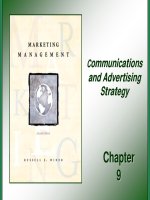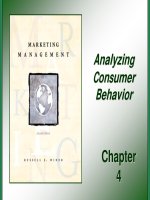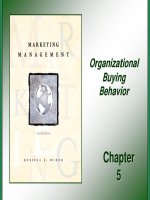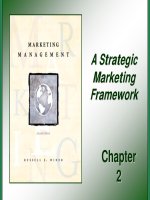Giáo trình: Marketing Management_ Chapter 9
Bạn đang xem bản rút gọn của tài liệu. Xem và tải ngay bản đầy đủ của tài liệu tại đây (949.06 KB, 47 trang )
Communications
and Advertising
Strategy
Chapter
9
9-1
Key Learning Points
Basic model of communication and how
technology is changing that model.
Elements of an IMC program.
Setting advertising goals and selecting
target audiences.
Developing message strategies.
Key elements of media planning.
How advertising budgets are set.
Alternative approaches to evaluating
advertising spending.
9-2
Product & Service
“Forward-looking organizations are
Decisions
stressing a concept called integrated
marketing communications (IMC), in
which the marketing manager does not
think of all the elements of the
marketing mix as communicating
separate messages; these messages
are coordinated to reinforce what each
is saying and to prevent customer
confusion from conflicting messages.”
- Russell S. Winer
9-3
Figure 9-1:
Model of the
Communication Process
9-4
Communications
Senders (sources) encode messages
in a way that resonates with the
receiver (target audience) when they
are decoded.
Types of message channels:
– Personal
• Salespeople, opinion leaders, word-of-mouth
– Nonpersonal
• Mass media: television, newspapers, radio,
direct mail, billboards, magazines, Internet
9-5
Communications
Figure 9.2 demonstrates the one-tomany aspect of mass communication.
– Assumes no interaction between
customers and firms.
• In actuality, customer feedback from mass
communication exists, but is very slow.
– Content is not personalized.
9-6
Figure 9-2:
Traditional Mass Marketing
Communications Model
9-7
Communications
The new technological environment has
impacted communication substantially.
– E-mail, newsgroups, listservs, web sites, web
surveys, and brand communities make
communication quick and easy.
– Customers can also customize or create their
own content, as shown in Figure 9.3.
– Trade-offs exist between richness and reach as
illustrated in Figure 9.4.
9-8
Discussion Questions
Successfully managing brand communities
is a key challenge facing marketers today.
1. Generating positive word-of-mouth via a
brand community could be very beneficial.
What actions could you take?
2. Minimizing negative or wrong information is
equally important. What could you do?
3. Why should brand communities for
competitive products be investigated?
4. What are the ethical aspects involved with
managing brand communities?
9-9
Figure 9-3:
Modified Mass Marketing
Communications Model
9 - 10
Figure 9-4:
Traditional Trade-off
Between Richness & Reach
9 - 11
In-Class Activity
Where would you place the following on this chart?
* Personal selling
* Opt-in e-mail
* E-mail SPAM
* Newspapers
* Banner ads
* Network TV
* Direct mail
* Magazines
* Outdoor
* Radio
9 - 12
Integrated Marketing
Communications
Consumer goods companies spend the
highest percentage of their marketing
communications expenditures on different
media than do business-to-business firms.
– TV expenditures by consumer goods
companies are nearly three times that of the
next largest expenditure category (literature,
coupons, and point-of-purchase).
– The top two business-to-business marketing
communications expenditure categories are
print advertising and direct mail.
9 - 13
Figure 9-5:
Elements of the
Communication Mix
9 - 14
Integrated Marketing
Communications
Mix Elements
Advertising
Direct Marketing
Sales Promotion
Publicity/Public
Relations
Personal Selling
Miscellaneous
Advertising advantages:
–
–
–
Message content control
Very large reach
Flexibility: images,
symbols, and creative/
copy strategies
Advertising drawbacks:
– Evaluating effectiveness
is difficult
– Often very expensive
– Waste
– Noise
– Clutter
9 - 15
Integrated Marketing
Communications
Mix Elements
Advertising
Direct Marketing
Sales Promotion
Publicity/Public
Relations
Personal Selling
Miscellaneous
Direct marketing forms:
–
–
–
–
Telemarketing
Direct-mail marketing
Direct sales
Internet
Key advantages:
– Customized messages
– Little waste
– Evaluation is easy
Key drawbacks:
–
–
–
–
Consumer dislike
Global restrictions
Clutter
Low response rates
9 - 16
Integrated Marketing
Communications
Mix Elements
Advertising
Direct Marketing
Sales Promotion
Publicity/Public
Relations
Personal Selling
Miscellaneous
Sales Promotions:
– Provide extra incentives to
consumers or trade in order
to achieve a short-term
objective.
Consumer-Oriented:
– Coupons, sweepstakes,
rebates, samples, and pointof-purchase savings
– Objective: short-term sales
Trade-Oriented:
– Sales contests, training, and
quantity discounts
– Objective: distribution
9 - 17
Integrated Marketing
Communications
Mix Elements
Advertising
Direct Marketing
Sales Promotion
Publicity/Public
Relations
Personal Selling
Miscellaneous
Key advantages:
– Generate measurable shortterm responses
– Induce new product trial
– Reinforce brand image
– Generate repeat purchase
– Gain shelf space
Key drawbacks:
– Price-focused
• Detracts from brand equity
– Consumers may become
conditioned to expect deals
– Effects are short-lived
9 - 18
Integrated Marketing
Communications
Mix Elements
Advertising
Direct Marketing
Sales Promotion
Publicity/Public
Relations
Personal Selling
Miscellaneous
Sponsoring organization
normally does not pay for the
communication.
Publicity typically takes the
form of an article in a
magazine/newspaper or TV
news coverage.
Key advantage:
– More credible than
advertising.
Key drawback:
– Sponsoring company has
little control.
9 - 19
Integrated Marketing
Communications
Mix Elements
Advertising
Direct Marketing
Sales Promotion
Publicity/Public
Relations
Personal Selling
Miscellaneous
Personal selling is the use of
face-to-face communications
between seller and buyer.
– Largest part of marketing
budget for business-tobusiness marketers.
Key advantages:
– Customized presentations
– Immediate feedback to
questions
Key drawbacks:
–
–
Expensive
Control over final message
delivered by sales
representative is difficult
9 - 20
Integrated Marketing
Communications
Mix Elements
Advertising
Direct Marketing
Sales Promotion
Publicity/Public
Relations
Personal Selling
Miscellaneous
Packaging
– Can communication
messages about benefits,
as well as image
Trade shows
– Key business-to-business
communication venue
Events and
sponsorships
Product placement in
movies and TV shows
Product demonstrations
9 - 21
Product & Service IMC
Absolut also practices
via its web site and sales
Decisions The cozy below
promotions.
was actually distributed.
Absolut Vodka’s ads have
transformed the brand
into an icon, and its ads,
into pieces of pop art.
9 - 22
9-
Advertising Management
Advertising is a major marketing
communications expense:
–
–
–
–
2002: $ 109 billion spent in U.S.
2002: $ 302 billion spent worldwide
Expected to increase by 3% in 2003
In 2001, the top U.S. brand advertiser (AT&T)
spent nearly $1 billion while the top B-to-B
advertiser (Verizon) spent $336 million.
– Recently, the proportion of the ad/promotion
budget spent on advertising has declined
while promotional expenditures have
increased.
9 - 23
Product & Service
Advertising Management
Decisions
Advertising
Key Decisions Decision Making
Target audience
selection
Goal setting
Message
strategy
Media planning
Budget setting
Measure of
advertising
effects
9 - 24
Advertising Management
Stage 1: Selecting the Target Audience
– Flows directly from marketing strategy.
– May include noncustomer targets.
Stage 2: Goal Setting
– Sales is typically not used as an advertising
objective except for direct-response ads.
– Models of how advertising creates a customer
response provide intermediate goals.
• Models all are all hierarchical and have three basic
stages: cognitive, affective, and behavioral.
• Choice of advertising goals may vary over the
product life cycle.
9 - 25









